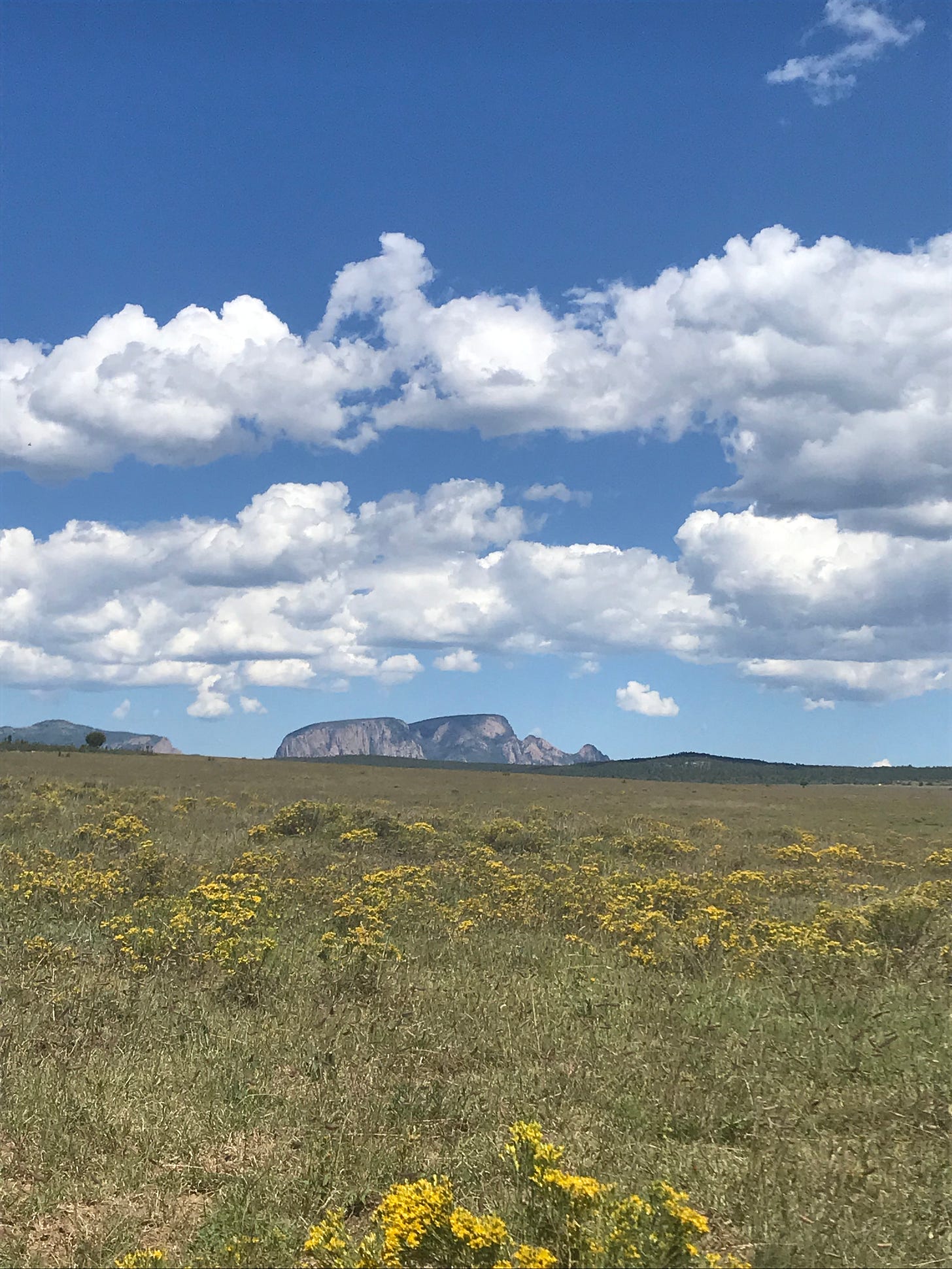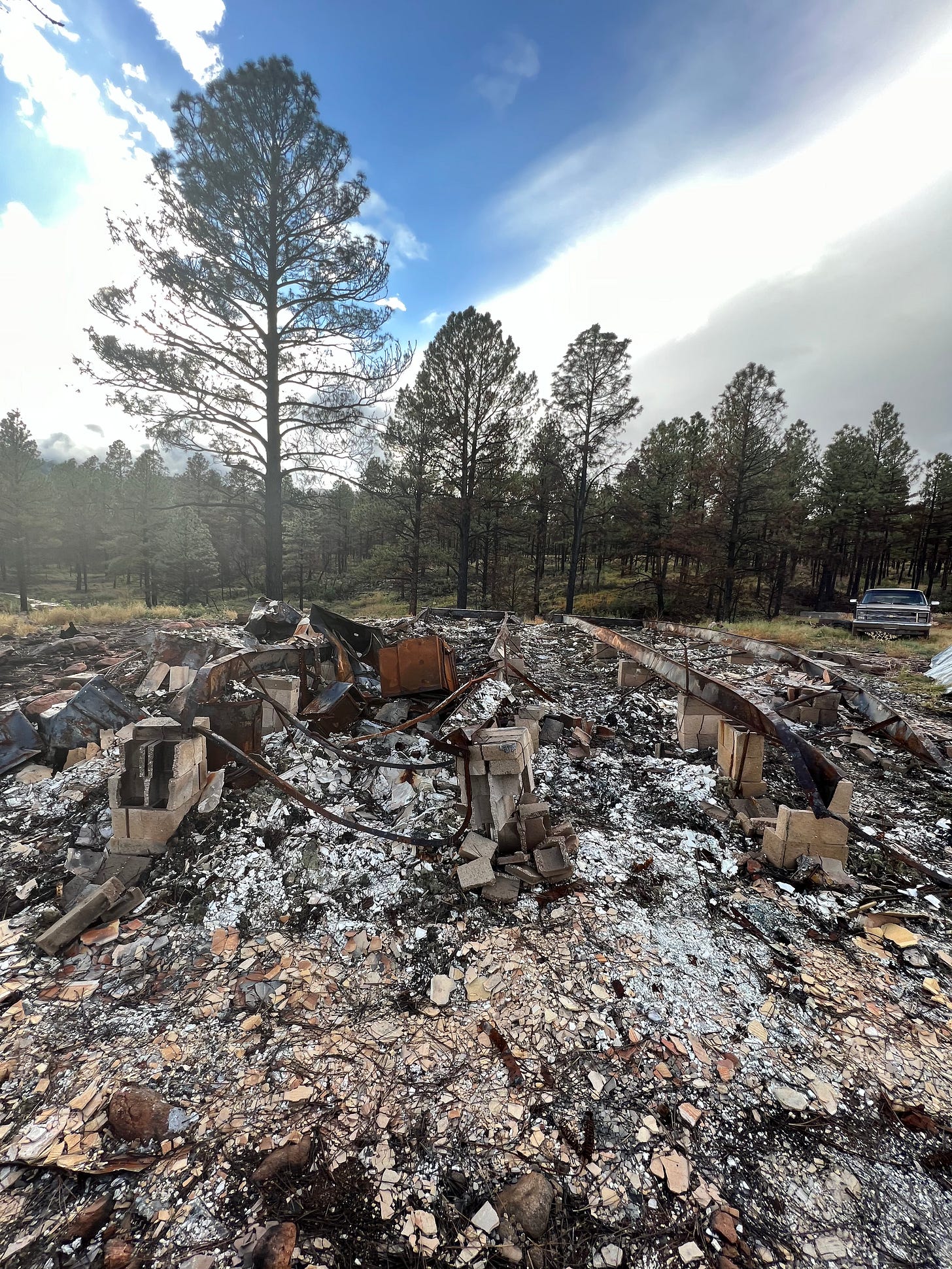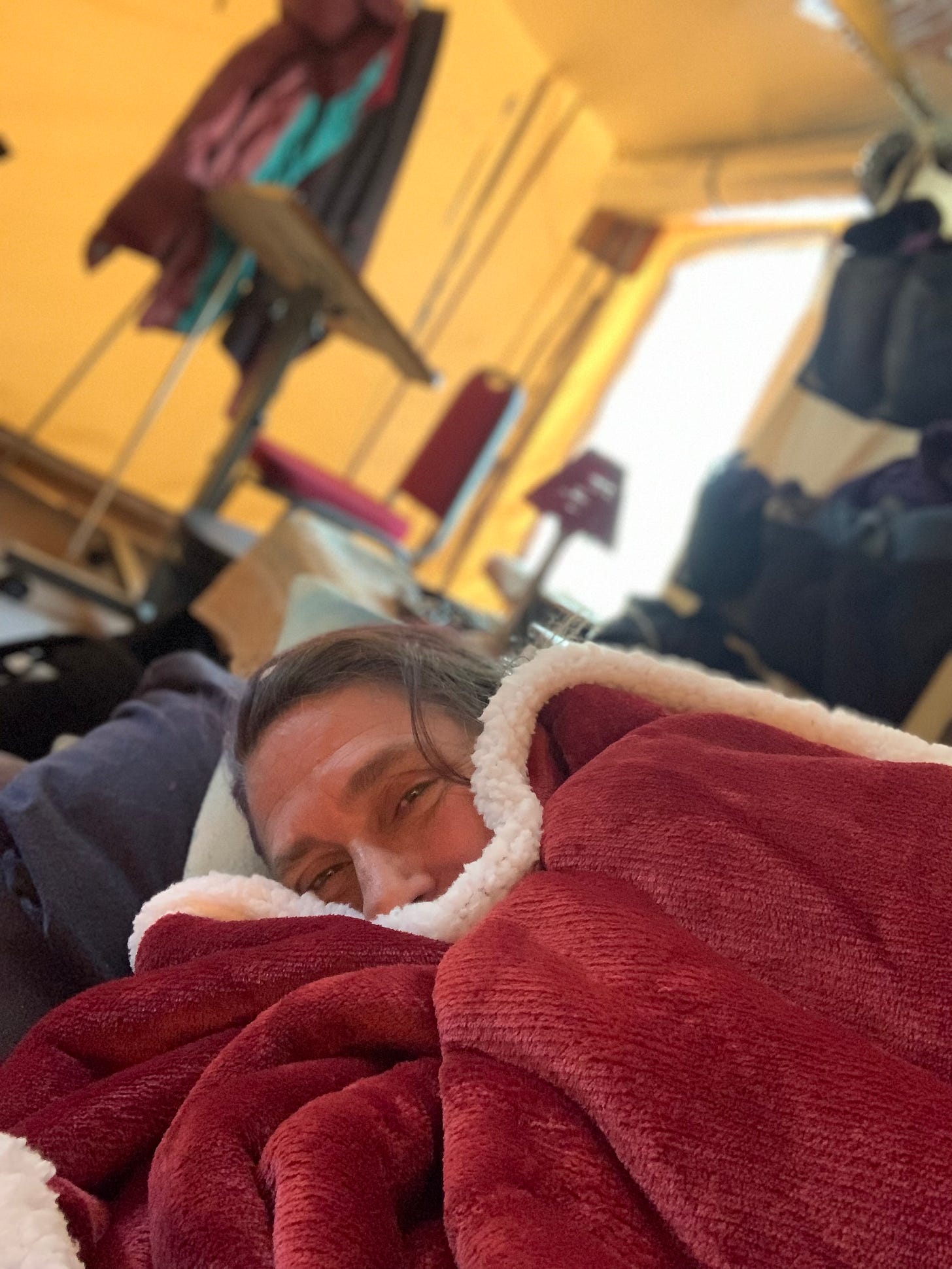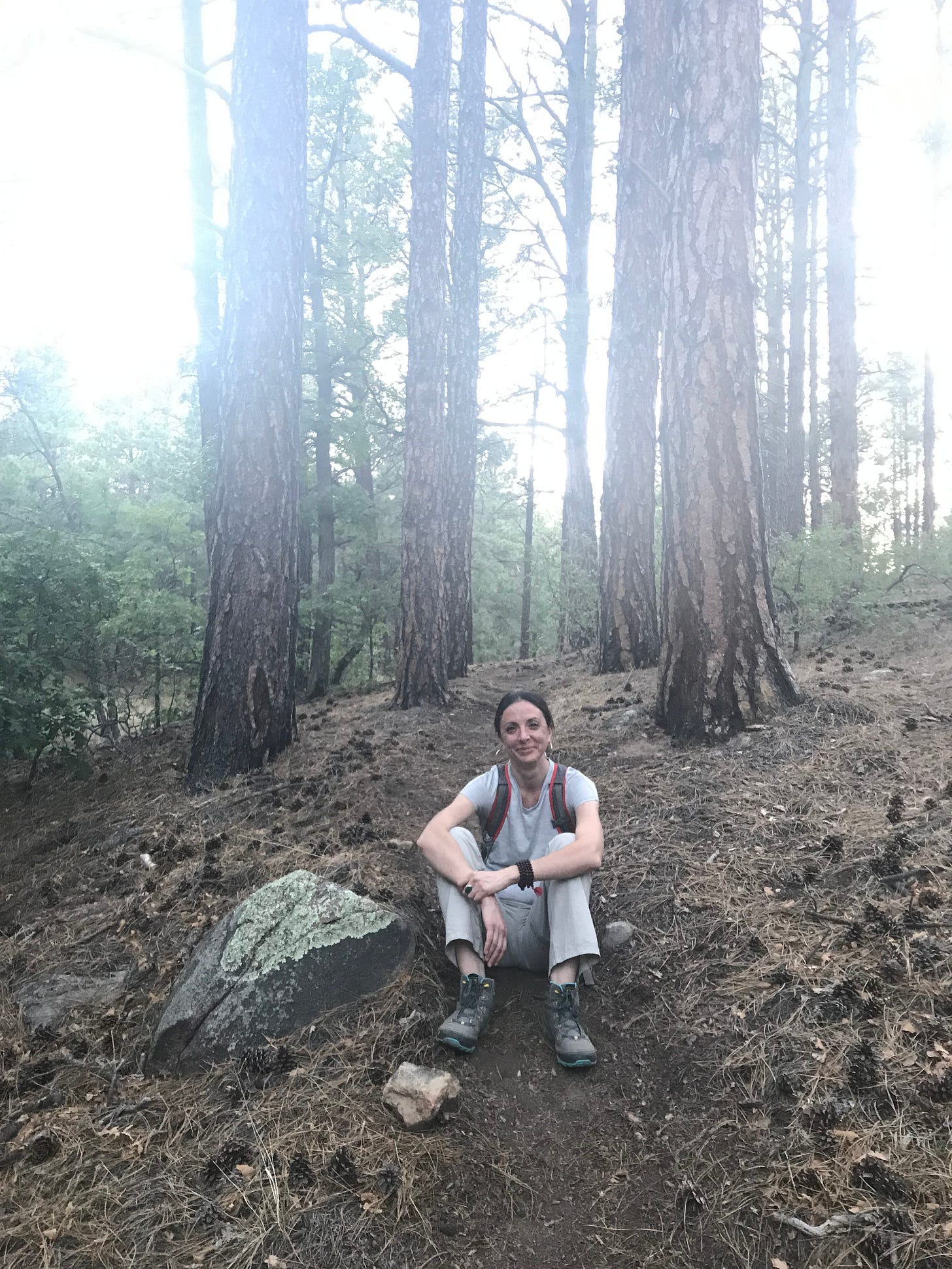Let me introduce the bear.
But first, some context.
The 180-acres of land I steward is miles down a side road off I-25, about 75 minutes from Santa Fe heading towards Colorado.
Turn left over the freeway through two rock ridges and a windy road that gains in altitude.
From the paved road, take a left at the fork onto the long gravel road.
In about fifteen minutes you will have to pull over next to miles of rolling golden or green grasslands and gaze in astonishment at the beauty of Hermit’s Peak. Take it in.
On the drive up to the land you wouldn’t know how much was lost in the wildfire, which started 30 miles away near the base of Hermit’s Peak. Today the meadows are filled with flowers, and for miles the cotton wood, ponderosa pine and piñon trees are untouched.
Here and there, patches of blackened trees. Around a corner, a hillside scorched on the right. Then the lull of green trees and fat cows knee-high in grass for miles.
It is not until you crest the hill above the village and see the panorama of fields and mountains stretched north and south before you that see the seemingly arbitrary patchwork, a quilt of life and death.
Look slightly left here, turning your head to between 10 and 11 o’clock. In front of the steep slope of the mountains you’ll see two gently sloping green hills, already covered with light green shrub oak. Those of us who live here know those trees were once covered with dark green pines.
Below those hills are enormous patches of black, with a thin line of green meandering through. The green follows the creek, which runs out of the national forest.
Drive down the hill toward the village.
Go over the wooden bridge, sharp left, sharp right, sharp left which will take you through a tiny village, population maybe six or so houses and one adobe church in disrepair. All safe only by the intense effort and dedication of the firefighters.
Follow the gravel road another mile or so to the huge black gate on the right.
Here the gravel road turns to red dirt. When it is dry it is quite passable. When it is rainy or snowy you must have skill, good nerves, and 4-wheel drive to traverse the rutted, sucky clay.
As you head west the Sangre de Cristo mountains, the most southernly tip of the Rockies, sheer straight up. As the raven flies, we are now due east of Santa Fe, except that there is 1.8 million acres of the Santa Fe National Forest spread between us and up north. The 9,340 foot top of Barillas Peak looks over the valley.
Make the sharp left where the road dead ends, go down the steep, rocky hill where cars scrape bottom and most people turn around, thinking they have lost the thread of the road. Just before the road dips momentarily and then travels upward, park your vehicle. Set the parking brake strongly. Get out and open the metal gate. Drive through. Close the metal gate. Get back in your car. Pause. Take a deep breath.
Skinny through the eroding road over the sometimes dry creek bed. Press hard on your gas pedal to get up the roller-coaster hill. Slow down just as you crest the top so your four tires stay attached to the ground.
Up ahead, if you know where to look, is the one house in the neighborhood that the volunteer fire department was not able to save.
The fire, which came from the north, shifted and somehow incinerated my neighbor’s house, melted glass, metal, and steel beam foundation, but left nearby trees and the propane tank untouched.
Say a prayer for Steve, who now lives in a small trailer down in town. Say a prayer for the thousands of families who lost their homes, livelihood, pets, and generational land from a “controlled burn” that married the wind and refused to be controlled.
Now drive onto the tiny dirt road that looks impassible until you round the scrub oak. Come up over the rocks, down the hill, up to the dirt parking lot. Here, in a circle around the community center, is an island of ponderosa pines, an oasis mostly untouched by the fire. Here is the human heart of the land: community kitchen, 30-foot yurt teaching space, storage shed, and nearly completed bathhouse which will have two composting toilets and two showers.
Between the yurt and our shed is a large 12 x 15 brown canvas tent I once lived in. Even though one side is completely melted and huge holes are melted into the roof, I’ve refused to take it down. It is such a friend and I’ll miss it terribly when we disassemble it for the last time.
Before the fire burned through the land we saw and heard deer and turkey, bears and cougar, fox and coyote. Owl, hawk, robin, sparrows. Post-fire the animals and birds that survived were slow to return, except the turkeys. The turkeys happily continued to forage in the blackened dirt, not seeming to notice the acres of dead trees.
The deer were much more cautious. For the first few months the only deer we found were in fragments: a charred hoof, a foreleg buried under charcoal. Eventually the survivors found their way back to the creek and their pathway between my neighbor’s unburned meadow and my other neighbor’s unburned forest.
Next we spotted cougar tracks in the snow, eight or so months post-fire. My heart fluttered with relief and joy to know that at least one cougar had escaped the flames and had enough food to survive.
The night I heard the first owl post-fire, I wept.
But it was the return of the bear which brought me the greatest joy.
I first met Baxter, as we started calling him, several years ago while sitting with my friend Mary down by the creek. All around us: green needled brown barked ponderosa pines as far as the eye could see.
As Mary and I sat chatting someone up the hill shouted:
“Bear!”
I yelled back “where?”
The response: “Across the creek!”
Mary and I spotted the bear at the same time, which was indeed right across the creek from us.
Here has been our protocol for bears:
No food, toothpaste, deodorant, or any type of strong smells in your tent.
Clap or sing while you are hiking to let the bears know you around.
If you see a bear back up slowly.
I have repeated these three statements over and over again, impressing on people the importance of not enticing or getting close to the bears.
Which is why it is hilarious that the first thing I did when I saw my first bear on the land was to run towards it.
As I ran I remembered: you shouldn’t be running towards a bear.
So I opened my arms and started yelling at the top of my lungs:
I LOVE YOU! I LOVE YOU! YOU CAN’T BE HERE!
The bear, who had been ambling along the creek minding its own business, took one look at my wild-eyed, arm waving joy and ran.
The bear came back into our camp one more time the next day, was firmly yelled at, and then never returned. I tracked the bear on our wildlife cameras, one camera on a tree in our common area by the creek and one which I had placed out in the national forest. The bear got the hint that there were weird animals who had staked the territory down below and it stayed away.
Note: these are black bears, known to be shy and dislike confrontation. In other words, they scare easily. Brown or grizzly bears, not so much. All the above rules still apply with all bears. Don’t run towards bears. Don’t run towards bears. Don’t run towards bears. But if you do find yourself running toward a bear make sure to tell them that you love them at the top of your lungs while waving your arms.
Mary and I loved the bear so much that we named him Baxter. We secretly made love offerings of watermelon and honey up in the national forest near where he showed up on the wildlife camera. (Don’t tell anyone.) We spoke fondly of him, and sent each other videos and pictures of bears.
After the wildfire there was no sign of bear. No big poops to brighten my day. No scratch marks on trees to show where it had claimed its own territory. No bears spotted on the wildlife cam, only turkeys and one mysterious red cow that no one claimed.
What had happened to Baxter? I feared the worst. Maybe he didn’t survive the fire. I hoped he had simply moved further south, beyond the edge of the fire line.
Which is why I was so ecstatic when somebody mysteriously dug up our very carefully planted experiment.
Baxter, is that you?
Part 3 of Seedballs, Willow Wattles, and the Bear Theft
Failures R Us
Tears streamed down all of our faces as Beata prayed in Tewa, the native language of this place. We were standing in a circle, holding hands and sharing blessings for regeneration and healing for the soil. This was a holy moment. This was a healing moment. Five humans, holding hands, asking for blessings from the ancestors of this land. Asking for guida…












Thank you for sharing the good and the bad with us. Your journey gives me hope. Blessed Be.
I was encouraged to come here from your visit with Kelly Sullivan Walden.
I love that knowledge of mycelium is pouring to people outside of my industry.
Fire does scorch and adapt the landscape especially when it is followed by heavy rains.
This year, in Alberta, fire and water has really affected our landscape.
The wildlife, including bears, have been disrupted and knowing that all bears can be territorial and unpredictable here, it is going to be a struggle to extend an intention like you did here to scared, disrupted territorial, hungry bears. But one can try.